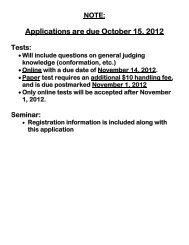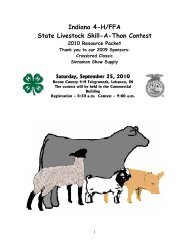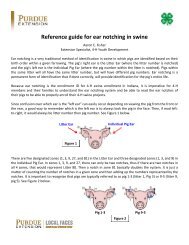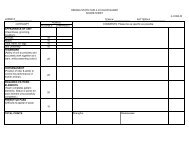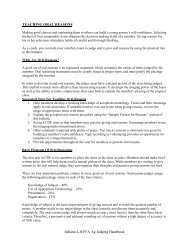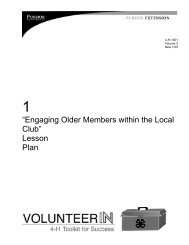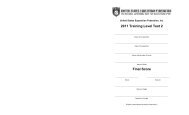36Appendix D. Background InformationFrom Illinois-Indiana <strong>Sea</strong> <strong>Grant</strong> website,http://www.iisgcp.org/unwantedmeds,Chapter 1.Introduction<strong>Unwanted</strong> medicine disposal is a rapidly emergingconcern that spans a broad range <strong>of</strong> issues includinghuman and environmental health, water quality,solid waste management, law enforcement, andthe health care industry. Substances <strong>of</strong> concern includeboth prescription and non-prescription medicines,and this category is sometimes expanded toinclude cleansing agents, cosmetics, nutritionalsupplements, and skin care products. The terms“medicine,” “medication” and “pharmaceutical”are used interchangeably throughout the documentsthat follow to refer to substances used intreating disease or illness. Another common termis PPCPs, which is an acronym for Pharmaceuticalsand Personal Care Products. There are thousands<strong>of</strong> products that fall into this classification; all <strong>of</strong>these substances are specifically designed to interactwith biological processes and are widely usedaround the world. They can enter the environmentwhen people dispose <strong>of</strong> medicines via trash or toilet,or after use when they are excreted in theiroriginal or metabolized form or rinsed <strong>of</strong>f the skinin the case <strong>of</strong> topical applications.The Issue<strong>Medicines</strong> are produced and prescribed in increasingvolumes every year (Figure 1). In the UnitedStates, sales <strong>of</strong> over-the-counter medicines haveincreased by 60% since the 1990s. 1 In 2006, the U.S.prescription volume rose to 3.7 billion prescriptions.2 With these increases comes concern aboutthe fate and effects <strong>of</strong> these compounds in the environment.Recent studies have identified a widerange <strong>of</strong> pharmaceutical chemicals in rivers andstreams nationwide, 3 and it has also been shownthat some <strong>of</strong> these compounds are potentiallyPercent <strong>of</strong> Persons Reporting Prescription Drug Use in the Past Month by AgeAll ages1988-19941999-2002Under18 years1988-19941999-2002One or two prescribed drugsThree or more prescribed drugs18-44years1988-19941999-200245-64years1988-19941999-200265 yearsand over1988-19941999-20020 10 20 30 40 50 60 70 80 90 100Figure 1. Prescription Drug Use. Source: National Health and Nutrition Examination Survey, 1999-2002. Center for DiseaseControl and Prevention. National Center for Health Statistics. Available at http://www.cdc.gov/nchs/nhanes.htm.1Ann Pistell, Maine Department <strong>of</strong> Environmental Protection. Presentation at Northeast Water Science Forum, August 9, 2007.2“IMS Intelligence.360: Global Pharmaceutical Perspectives 2006”, IMS Health Report, February 22, 2007.http://www.imshealth.com/ims/portal/front/articleC/0,2777,6599_40183881_81567488,00.html3Kolpin, Dana W., et al. “Pharmaceuticals, Hormones, and Other Organic Wastewater Contaminants in U.S. Streams, 1999-2000: A National Reconnaissance.” Environ. Science and Technology.Vol. 36 no. 6 (2002): pp. 1202-1211.
Appendix D. Background Information 37harmful to aquatic organisms, affecting reproductionand development even at low concentrations. 4The fate <strong>of</strong> pharmaceutical chemicals in sewagesludge is also <strong>of</strong> concern, as sludge from wastewatertreatment is <strong>of</strong>ten applied to agriculturalland as a fertilizer. The long-term impacts <strong>of</strong> medicinedisposal on our health and the health <strong>of</strong> theenvironment are not fully known. However, unlessaction is taken, the quantity <strong>of</strong> these chemicalsreaching our waterways will continue to increaseas pharmaceutical usage increases. Thus, Illinois-Indiana <strong>Sea</strong> <strong>Grant</strong> recommends a precautionaryapproach to this issue.So what can be done? The issues surroundingmedicine disposal are complex. Improper disposal<strong>of</strong> unwanted medicines can pose a risk tochildren and pets. For example, medicines placedin the trash without taking precautions to securethe container, make the medication unpalatable,or disguise the content are <strong>of</strong>ten accessible to childrenand pets, sometimes resulting in unintentionalpoisonings. And medicines disposed withtheir original labels intact can result in identitytheft and drug theft. This is an especially importantissue for the elderly, who are thebiggest consumers<strong>of</strong> prescribed medicines.In early 2007, both the American Pharmacists Association5 and the Office <strong>of</strong> National Drug ControlPolicy 6 issued guidelines for medicine disposal,following on the heels <strong>of</strong> several states providingadvice to their citizens. The two main components<strong>of</strong> both sets <strong>of</strong> national guidelines are:1. Don’t flush medications down the toilet andinstead,2. Remove labeling from packaging and dissolvesolid medications, mix with unpalatableitems (kitty litter, c<strong>of</strong>fee grounds, etc.)and seal in a bag before placing in the trash.<strong>Disposal</strong> to trash is considered by some organizationsto be an interim solution because medicinesplaced in landfills may ultimately reach wastewatertreatment plants and local streams andrivers. Illinois-Indiana <strong>Sea</strong> <strong>Grant</strong> believes thatcurrently, the best disposal solution is incineration<strong>of</strong> medications in a regulated incinerator. There is,however, a very long list <strong>of</strong> hurdles to overcomebefore a national disposal plan can be implementedthat is protective <strong>of</strong> humans, pets and ourenvironment. These hurdles include identifyingsafe and convenient medicine collection pathwaysand determining who will pay for this service.This resource kit was created to help communitiesdesign, establish and implement safe and propercollection programs. Included in the kit are severalexamples <strong>of</strong> pamphlets, fact sheets and educationmaterials that have been developed bycommunities and states as they wrestle with thiscomplicated issue. The recommendations and advicevary because jurisdictions are finding differentways to deal with the fact that only interimsolutions are available currently.The good news about this issue is that it touchesupon so many different aspects <strong>of</strong> our lives thatthere is no end <strong>of</strong> partners to join with to educateand reach out to the public. This issue impacts theelderly through drug and identity theft issues, accidentalpoisoning, and health care costs. It mattersto the police because prescription drug abuseby teenagers is on the rise. Concerns for the safety<strong>of</strong> children and pets also can drive behavioralchange. And for all <strong>of</strong> us, our health depends onthe health <strong>of</strong> our environment, including riversand streams and the creatures that live in them.Background<strong>Disposal</strong> <strong>of</strong> <strong>Unwanted</strong> <strong>Medicines</strong>For many reasons, medicines are not always entirelyused and therefore remain and may eventuallyexpire in the hands <strong>of</strong> consumers or healthcare facilities. Some reasons for this include:4For example, see Nash, Jon P., et al. “Long-Term Exposure to Environmental Concentrations <strong>of</strong> the PharmaceuticalEthynylestradiol Causes Reproductive Failure in Fish.” Environmental Health Perspectives. 112.17 (2004): pp. 1725-1733.5These guidelines were issued in cooperation with the U. S. Fish and Wildlife Service and can be found online athttp://www.aphanet.org/AM/Template.cfm?Section=<strong>New</strong>s_Releases1&CONTENTID=7481& TEMPLATE=/CM/ContentDisplay.cfm6Available online at http://www.ondcp.gov/news/press07/022007.html





